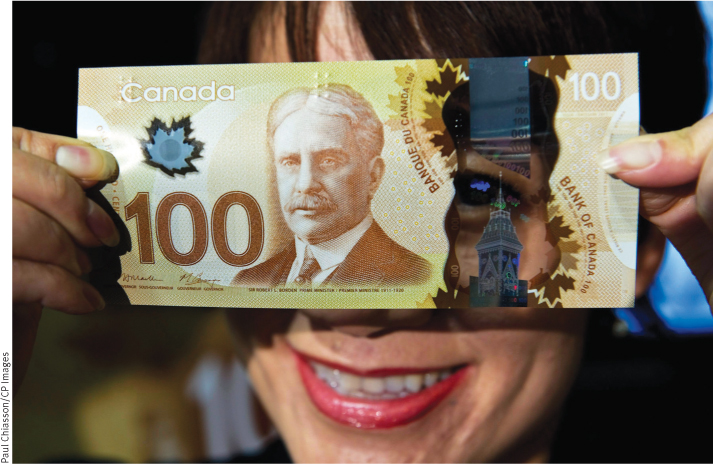Money, Banking, and the Central Banking System
14
The various roles money plays and the many forms it takes in the economy
How the actions of chartered banks and the Bank of Canada determine the money supply
How the Bank of Canada uses open-market operations to change the monetary base
FUNNY MONEY

IN 2008, THE ROYAL CANADIAN Mounted Police (RCMP) dismantled a major counterfeiting plant in Surrey, British Columbia, that was believed to be responsible for a significant portion of the counterfeit Canadian paper bills in B.C. between 2006 and 2008. A year later, the RCMP seized $130 000 worth of fake Canadian banknotes. In 2011, following a tip provided to Crime Stoppers and after a two-
The funny thing is that these elaborately decorated pieces of paper have little or no intrinsic value. Indeed, a $20 bill printed with blue or orange ink literally wouldn’t be worth the paper it was printed on. But if the ink on that decorated piece of paper is just the right shade of green, people will think that it’s money and will accept it as payment for very real goods and services. Why? Because they believe, correctly, that they can do the same thing: exchange that piece of green paper for real goods and services.
In fact, here’s a riddle: if a fake $20 bill enters Canada and nobody ever realizes it’s a fake, who gets hurt? Accepting a fake $20 bill isn’t like buying a car that turns out to be a lemon or a meal that isn’t edible; as long as the bill’s counterfeit nature remains undiscovered, it will pass from hand to hand just like a real $20 bill. The answer to the riddle, as we’ll learn later in this chapter, is that the real victims of counterfeiting are Canadian taxpayers, because counterfeit dollars reduce the revenues available to pay for the operations of the Canadian government. Accordingly, the RCMP diligently monitors the integrity of Canadian currency, promptly investigating any reports of counterfeit dollars. The Bank of Canada (BOC) continues to bolster the security features of our paper bills and increase education efforts on note checking. The recent introduction of the polymer series of banknotes with improved security features is an example of the effort by the BOC to reduce counterfeiting.
The activities of the BOC and RCMP attest to the fact that money isn’t like assets. It plays a unique role in the economy as the essential channel that links the various parts of the modern economy. In this chapter, we’ll look at the role money plays, and then look at how a modern monetary system works and at the institutions that sustain and regulate it. This topic is important in itself, and it’s also essential background for the understanding of monetary policy, which we will examine in the next chapter. 